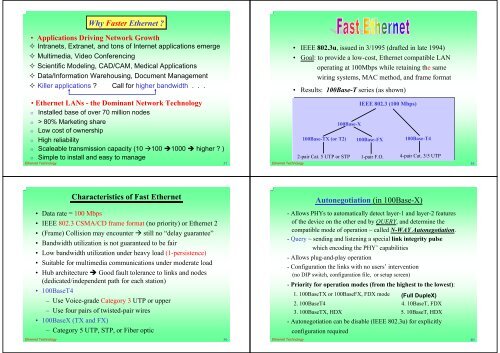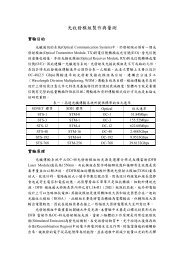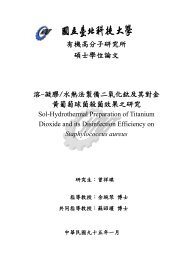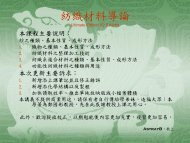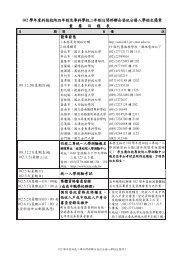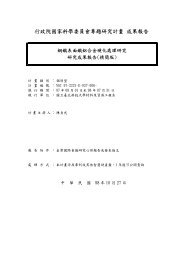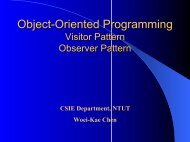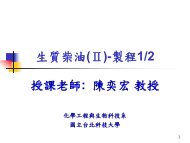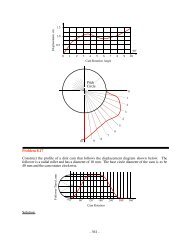Ethernet Technology
Ethernet Technology
Ethernet Technology
Create successful ePaper yourself
Turn your PDF publications into a flip-book with our unique Google optimized e-Paper software.
Why Faster <strong>Ethernet</strong> ?<br />
• Applications Driving Network Growth<br />
Intranets, Extranet, and tons of Internet applications emerge<br />
Multimedia, Video Conferencing<br />
Scientific Modeling, CAD/CAM, Medical Applications<br />
Data/Information Warehousing, Document Management<br />
Killer applications ? Call for higher bandwidth . . .<br />
• <strong>Ethernet</strong> LANs - the Dominant Network <strong>Technology</strong><br />
Installed base of over 70 million nodes<br />
> 80% Marketing share<br />
Low cost of ownership<br />
High reliability<br />
Scaleable transmission capacity (10 100 1000 higher ? )<br />
Simple to install and easy to manage<br />
<br />
<strong>Ethernet</strong> <strong>Technology</strong> 37<br />
• IEEE 802.3u, issued in 3/1995 (drafted in late 1994)<br />
• Goal: to provide a low-cost, <strong>Ethernet</strong> compatible LAN<br />
operating at 100Mbps while retaining the same<br />
wiring systems, MAC method, and frame format<br />
• Results: 100Base-T series (as shown)<br />
100Base-TX (or T2)<br />
100Base-X<br />
2-pair Cat. 5 UTP or STP<br />
IEEE 802.3 (100 Mbps)<br />
100Base-FX<br />
1-pair F.O.<br />
100Base-T4<br />
4-pair Cat. 3/5 UTP<br />
<strong>Ethernet</strong> <strong>Technology</strong> 38<br />
Characteristics of Fast <strong>Ethernet</strong><br />
• Data rate = 100 Mbps<br />
• IEEE 802.3 CSMA/CD frame format (no priority) or <strong>Ethernet</strong> 2<br />
• (Frame) Collision may encounter still no “delay guarantee”<br />
• Bandwidth utilization is not guaranteed to be fair<br />
• Low bandwidth utilization under heavy load (1-persistence)<br />
• Suitable for multimedia communications under moderate load<br />
• Hub architecture Good fault tolerance to links and nodes<br />
(dedicated/independent path for each station)<br />
• 100BaseT4<br />
– Use Voice-grade Category 3 UTP or upper<br />
– Use four pairs of twisted-pair wires<br />
• 100BaseX (TX and FX)<br />
– Category 5 UTP, STP, or Fiber optic<br />
<strong>Ethernet</strong> <strong>Technology</strong> 39<br />
Autonegotiation (in 100Base-X)<br />
- Allows PHYs to automatically detect layer-1 and layer-2 features<br />
of the device on the other end by QUERY, and determine the<br />
compatible mode of operation ~ called N-WAY Autonegotiation.<br />
- Query ~ sending and listening a special link integrity pulse<br />
which encoding the PHY’ capabilities<br />
- Allows plug-and-play operation<br />
- Configuration the links with no users’ intervention<br />
(no DIP switch, configuration file, or setup screen)<br />
- Priority for operation modes (from the highest to the lowest):<br />
1. 100BaseTX or 100BaseFX, FDX mode (Full DupleX)<br />
2. 100BaseT4 4. 10BaseT, FDX<br />
3. 100BaseTX, HDX 5. 10BaseT, HDX<br />
- Autonegotiation can be disable (IEEE 802.3u) for explicitly<br />
configuration required<br />
<strong>Ethernet</strong> <strong>Technology</strong> 40


